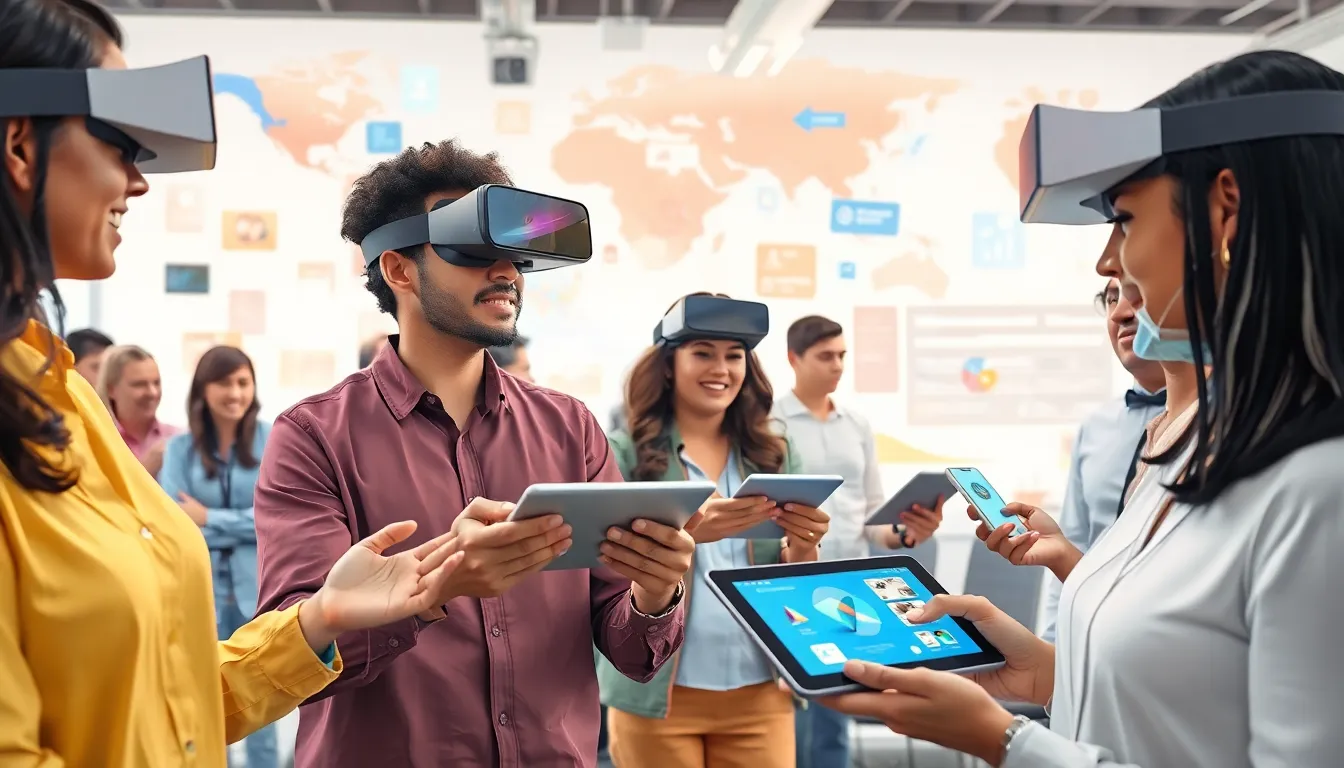Table of Contents
ToggleImagine walking into a room and instantly transforming it into a tropical paradise or a bustling cityscape, all without breaking a sweat. That’s the magic of AR software. It’s not just for gamers or tech enthusiasts anymore; it’s revolutionizing how businesses operate and how people interact with the world around them.
Overview of AR Software
AR software integrates digital elements with the physical world, enhancing the user experience. Multiple industries leverage this technology for improved interaction and functionality. Retailers utilize AR for virtual try-ons, allowing customers to visualize products before purchase.
Healthcare applications of AR assist in medical training and surgeries, providing real-time visual guidance. Education also benefits, as AR facilitates interactive learning experiences that captivate students.
Developers create AR experiences using tools like Unity and Vuforia, which support various platforms and devices. These tools enable the creation of rich, immersive environments with overlays of information.
Moreover, analytics show that AR can increase customer engagement significantly, with businesses reporting higher conversion rates. Companies embracing AR software often find a competitive edge, as innovation drives consumer interest.
As AR technology advances, it continues to evolve, fostering new opportunities across sectors. Businesses investing in AR solutions can capitalize on the growing demand for interactive experiences. Industries now recognize the value of AR in bridging the gap between digital and physical realms.
Collaborative tools enhance teamwork and productivity through AR, transforming traditional workflows. With applications in remote assistance, team members can visualize tasks together, regardless of location.
Overall, the integration of AR software into everyday activities shapes how people interact with information and their environment. It enhances engagement while providing practical solutions that streamline processes and improve outcomes.
Key Features of AR Software

AR software features several components that enhance user interaction and operational efficiency. These components include user-friendly interfaces and robust functionalities tailored for various applications.
User Interface Design
User interface design focuses on creating intuitive experiences. Visual elements serve to guide users through the AR environment seamlessly. Layouts prioritize accessibility, ensuring users with varying skill sets find the software easy to navigate. Engaging graphics capture attention, while interactive buttons encourage exploration. Consistent design across platforms fosters familiarity, enhancing user comfort with the technology.
Functionality and Usability
Functionality and usability play crucial roles in AR software success. AR applications integrate real-time data overlays, providing users with essential information instantly. Realistic simulations enhance training experiences, while collaborative features support teamwork remotely. Ease of use shapes user satisfaction, encouraging frequent interaction. Comprehensive support resources help troubleshoot common issues, promoting smoother experiences. Feedback mechanisms allow users to communicate their needs, leading to continuous improvement of the software.
Applications of AR Software
AR software transforms various sectors by enriching user experiences. Its adaptability allows businesses to engage consumers in innovative ways.
Industries Utilizing AR Software
Retailers leverage AR software for virtual try-ons, enhancing consumer interaction with products. In healthcare, AR assists surgeons by providing real-time overlays during operations. Education institutions implement AR for interactive learning, making complex subjects easier to grasp. Construction firms use AR for visualization, aiding in project planning and execution. Automotive companies incorporate AR for virtual showrooms, offering customers a unique vehicle experience.
Case Studies of AR Software in Action
IKEA’s Place app allows users to visualize furniture in their homes before purchasing, significantly reducing returns. The Pokémon GO game blended gaming with real-world exploration, attracting millions of players globally. In healthcare, AccuVein uses AR to help locate veins, improving the accuracy of injections. Boeing utilizes AR to streamline aircraft assembly, increasing efficiency and reducing errors. Land Rover’s Range Rover AR app enables consumers to explore their vehicles’ features interactively, enhancing the buying experience.
Pros and Cons of AR Software
AR software presents unique opportunities and challenges in various sectors. Understanding its advantages and disadvantages helps organizations make informed decisions.
Advantages of AR Software
AR software enhances user experiences through interactive engagement. Retailers see significant boosts in conversion rates using virtual try-ons. Medical training benefits greatly from real-time simulations, which improve learning outcomes. Educational institutions find interactive learning tools foster deeper understanding. Access to robust analytics enables businesses to tailor their services effectively. Users experience intuitive interfaces, making navigation simple and enjoyable. Increased collaboration opportunities arise, especially in remote teams, allowing for seamless teamwork.
Disadvantages of AR Software
AR software poses specific challenges that organizations must consider. High development costs can hinder smaller companies from adopting the technology. Limited compatibility with existing systems may require additional investment. Technical issues, such as connectivity problems, can disrupt user experiences, leading to frustration. Users might encounter a steep learning curve, impacting the software’s overall usability. Privacy concerns also arise, especially with data collection practices. Specific devices, such as smartphones or AR glasses, restrict access, limiting the audience.
Future Trends in AR Software
Growth in augmented reality (AR) software continues at a rapid pace, driven by technological advancements. Increased integration of artificial intelligence enhances user experiences, enabling smarter interactions. Collaborative platforms incorporate AR to facilitate remote work, fostering seamless communication. Adoption of 5G networks boosts AR applications, facilitating real-time experiences with minimal latency.
Personalization trends influence AR software development significantly. Customizable features allow users to tailor experiences according to their preferences, increasing engagement. Retailers utilize AR for personalized shopping experiences, enhancing customer satisfaction and loyalty. Data analytics play a pivotal role, guiding businesses in understanding user behavior and refining AR applications accordingly.
Healthcare professionals embrace AR for improving patient experiences and training programs. Surgical simulations using AR technology allow for enhanced visualization and precision during procedures. Educational institutions implement AR tools to create immersive learning environments, engaging students in interactive ways.
The transportation sector sees AR software being integrated into navigation systems. Drivers benefit from real-time information displayed on windshields, improving safety and efficiency. Automotive companies design AR-driven applications to enhance the car-buying experience, allowing potential buyers to visualize features interactively.
Future developments in AR software promise innovative solutions for various industries. Diverse applications in architecture, gaming, and tourism highlight the technology’s versatility. Companies focusing on creating more intuitive interfaces drive AR usability forward, ensuring broader adoption across different demographics. Enhanced AR experiences continue to attract both businesses and consumers, fundamentally transforming human interactions with digital content.
The rise of AR software marks a significant shift in how individuals and businesses interact with their environments. Its ability to blend digital elements with the physical world creates immersive experiences that enhance engagement across various sectors. As technology continues to evolve AR applications are set to become even more integral to everyday life.
Businesses that embrace AR stand to gain a competitive edge by meeting the growing demand for innovative solutions. The focus on user-friendly interfaces and robust functionalities ensures that AR remains accessible and effective. With ongoing advancements in AI and 5G technology the future of AR promises even greater possibilities for transforming user experiences and improving operational efficiency.







